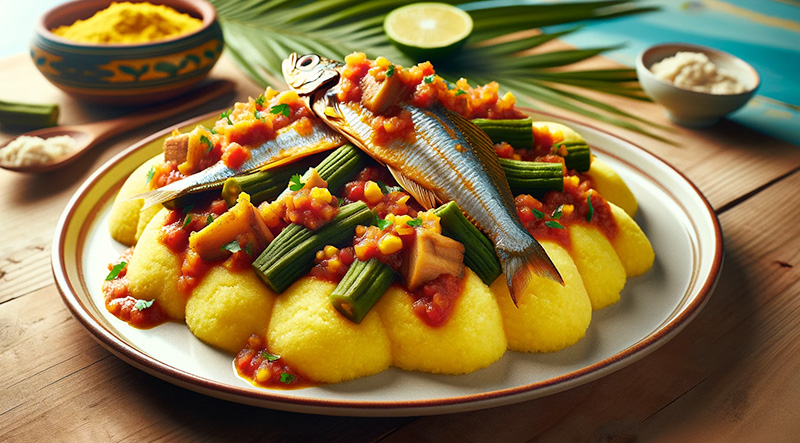Cou-cou and Flying Fish, the national dish of Barbados, is a quintessential representation of the island's culinary heritage. Cou-cou, akin to polenta or grits, is made from cornmeal mixed with okra, or sometimes breadfruit and green bananas, and cooked to a smooth consistency using a traditional wooden paddle. Flying Fish, a symbol of Barbados, is commonly seasoned with local herbs and spices and then steamed or fried. It is often accompanied by a flavorful sauce made from tomatoes and onions. This dish not only offers a taste of Barbadian flavors but also reflects the island's reliance on both the sea and agricultural produce, making it a cherished part of the Bajan culture. Read More...
For Cou-cou:
For Flying Fish:

Prepare the Sauce:

To Serve:
Enjoy your meal! Remember, like many traditional dishes, there are variations to this recipe, so feel free to adjust the ingredients and seasonings to suit your taste.
Preparing and cooking Cou-cou and Flying Fish, the national dish of Barbados, typically takes about 1 to 1.5 hours in total. This includes marinating the fish for about 15-30 minutes, which is essential for flavor infusion. The Cou-cou preparation, involving cooking okra and then combining it with cornmeal, requires continuous stirring and takes about 30-40 minutes to achieve the right consistency. Cooking the Flying Fish is relatively quick, approximately 5-10 minutes, depending on the method (steaming or frying). The sauce for the fish, made with onions, garlic, bell peppers, and tomatoes, adds another 10-15 minutes to the cooking process. Overall, while the dish involves several steps, most of them are straightforward and can be managed simultaneously, making it a rewarding culinary endeavor that yields a dish rich in flavor and cultural significance.
A typical serving of Cou-cou and Flying Fish, the national dish of Barbados, contains an estimated 300-500 calories. The calorie count mainly depends on the portion size and cooking method. Cou-cou, made from cornmeal and okra, contributes a moderate amount of calories, primarily from carbohydrates. The calorie content of the Flying Fish varies based on whether it is steamed or fried; frying adds more calories due to oil absorption. The accompanying sauce, if made with oil and other seasonings, can also add to the calorie count, albeit to a lesser extent. Despite this, the dish offers a balance of nutrients, including proteins from the fish and fiber from the vegetables, making it a wholesome and flavorful meal option.



